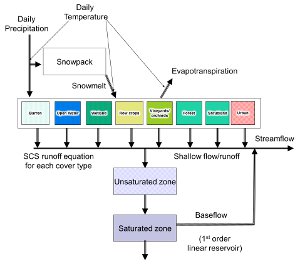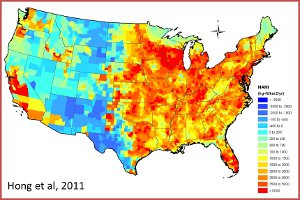Led largely by Dennis Swaney and Bongghi Hong, the lab has a major emphasis on modeling at the scale of large watersheds and regions,
using both statistically based models such as NANI and mechanistically based models such as ReNuMa.
ReNuMa is a large-watershed-scale model based on the Generalized Watershed Loading Function model (Haith and Shoemaker, 1987) which allows
planners and other stakeholders to explore scenarios for reducing nitrogen fluxes from the landscape. Unlike previous models, ReNuMa allows
for biogeochemical parameters such as denitrification or within-soil, riparian-zone, and in-stream processes and explicitedly considers
atmospheric nitrogen inputs NOx, NHx).
Net Anthropogenic Nitrogen Inputs (NANI), originally developed as part of the International Scientific Committee on Problems of the
Environment (SCOPE) Nitrogen Project, is a nutrient accounting approach used to analyze the relative contribution of various
nitrogen (N) sources and sectors to riverine N fluxes. The corresponding approach for phosphorus (NAPI) follows a similar
methodology. We have applied NANI/NAPI at various spatial scale ranging from individual watersheds to large (to 4,000,000 km²)
regions and found that they are well correlated to the average N or P fluxes in rivers in the United States, Europe and Asia, as
discussed in several of the papers found below.
Role of external inputs of nutrients to aquatic ecosystems in determining prevalence of nitrogen vs. phosphorus limitation of net primary productivity. In Biogeochemistry
Phosphorus use efficiency and crop production: Patterns of regional variation in the United States, 1987–2012. In Science of The Total Environment
Nitrogen use efficiency and crop production: Patterns of regional variation in the United States, 1987–2012. In Science of The Total Environment
Anthropogenic Phosphorus Inputs to a River Basin and Their Impacts on Phosphorus Fluxes Along Its Upstream-Downstream Continuum. In Journal of Geophysical Research: Biogeosciences
Advances in NANI and NAPI accounting for the Baltic drainage basin: spatial and temporal trends and relationships to watershed TN and TP fluxes. In Biogeochemistry
A system dynamics model for managing regional N inputs from human activitites. In Ecological Modelling
Evaluating anthropogenic N inputs to diverse lake basins: A case study of three Chinese lakes. In Ambio
Enhanced N input to Lake Dianchi Basin from 1980 to 2010: Drivers and consequences. In Science of The Total Environment
Net anthropogenic nitrogen fluxes from Indian watersheds: An initial assessment. In Journal of Marine Systems
Anthropogenic point and non-point nitrogen inputs into Huai River Basin and their impacts on riverine ammonia-nitrogen flux. In Biogeosciences Discussions
Estimating net anthropogenic nitrogen inputs (NANI) to US watersheds: comparison of methodologies. In Environmental Science & Technology
Nitrogen fluxes from large watershed to coastal ecosystems controlled by net anthropogenic nitrogen inputs and climate. In Frontiers in Ecology & Environment
Evaluating regional variation of net anthropogenic nitrogen and phosphorus inputs (NANI/NAPI), major drivers, nutrient retention pattern and management implications in the multinational areas of Baltic Sea basin. In Ecological Modeling
Net anthropogenic nitrogen inputs to watersheds and a riverine N export to coastal waters: a brief overview. In Current Option in Environmental Sustainability
Historical changes in the food and water supply systems of the New York City metropolitan area. In Regional Environmental Change
A toolbox for calculating net anthropogenic nitrogen inputs (NANI). In Environmental Modeling and Software
Estuarine classification and response to nitrogen loading: Insights from simple ecological models. In Estuarine, Coastal, and Shelf Science
The influence of climate on average nitrogen export from large watersheds in the northeastern United States. In Biogeochemistry
Anthropogenic nitrogen sources and relationships to riverine nitrogen export in the northeastern USA. In Biogeochemistry
Riverine inputs of nitrogen to the North Atlantic Ocean: Fluxes and human influences. In Biogeochemistry

